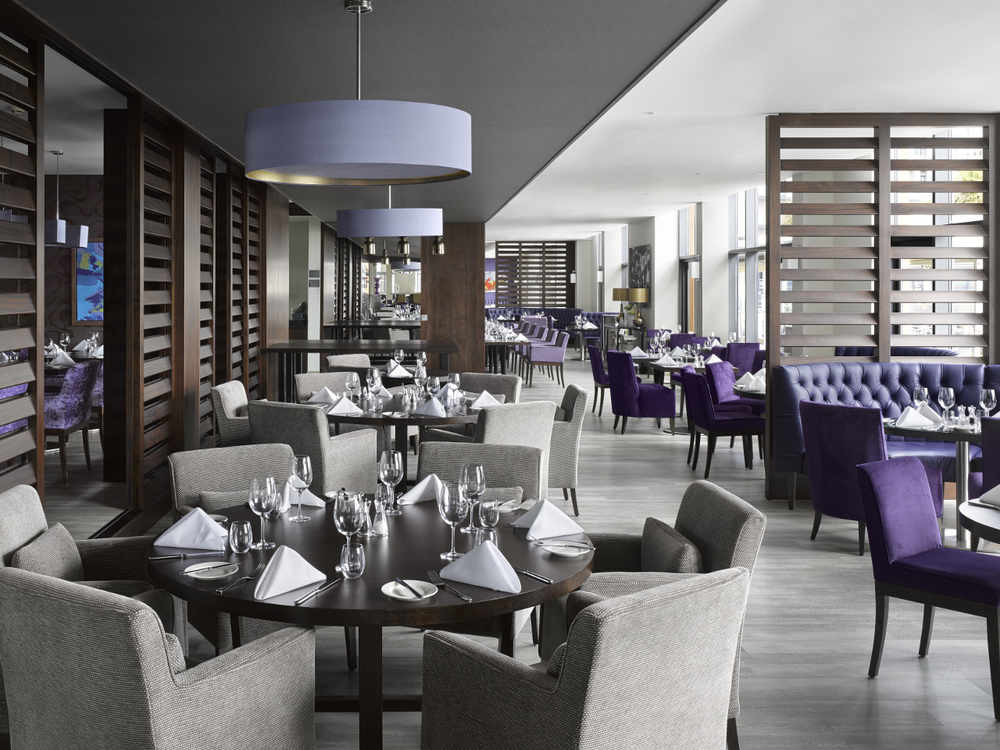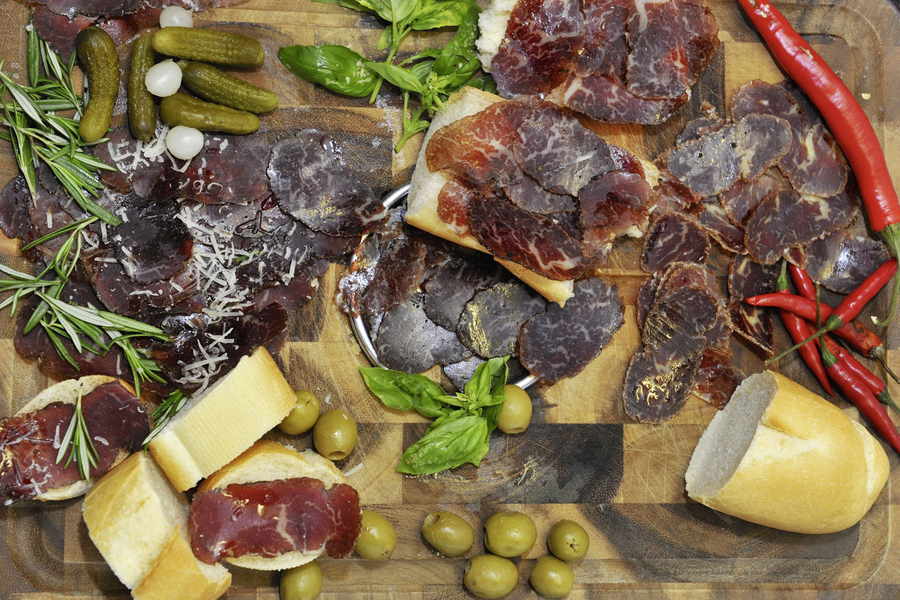Inspired by her European heritage, Georgina Reid has started curing Jersey beef using traditional techniques and homegrown products – Caroline Moody reports
GEORGINA Reid grew up around food, and the Roseville Bistro has been run by her family for 50 years – first by her parents, Franz and Ann Zonta, both chefs, and now by her sister Jo.
‘I was born in Gran Canaria on a family holiday while the restaurant was shut for the winter period,’ said Georgina.
‘Because my dad is Austrian and my godparents are Spanish, I grew up around continental food, like salami, pastrami, Parma ham, bresaola. It’s always been on the dinner table, and the antipasti platter was always the starter when we went out for dinner. I can eat it by the bucketload!’
About a year ago, Georgina had the idea that she wanted to see if she could create cured beef from the Jersey cow.
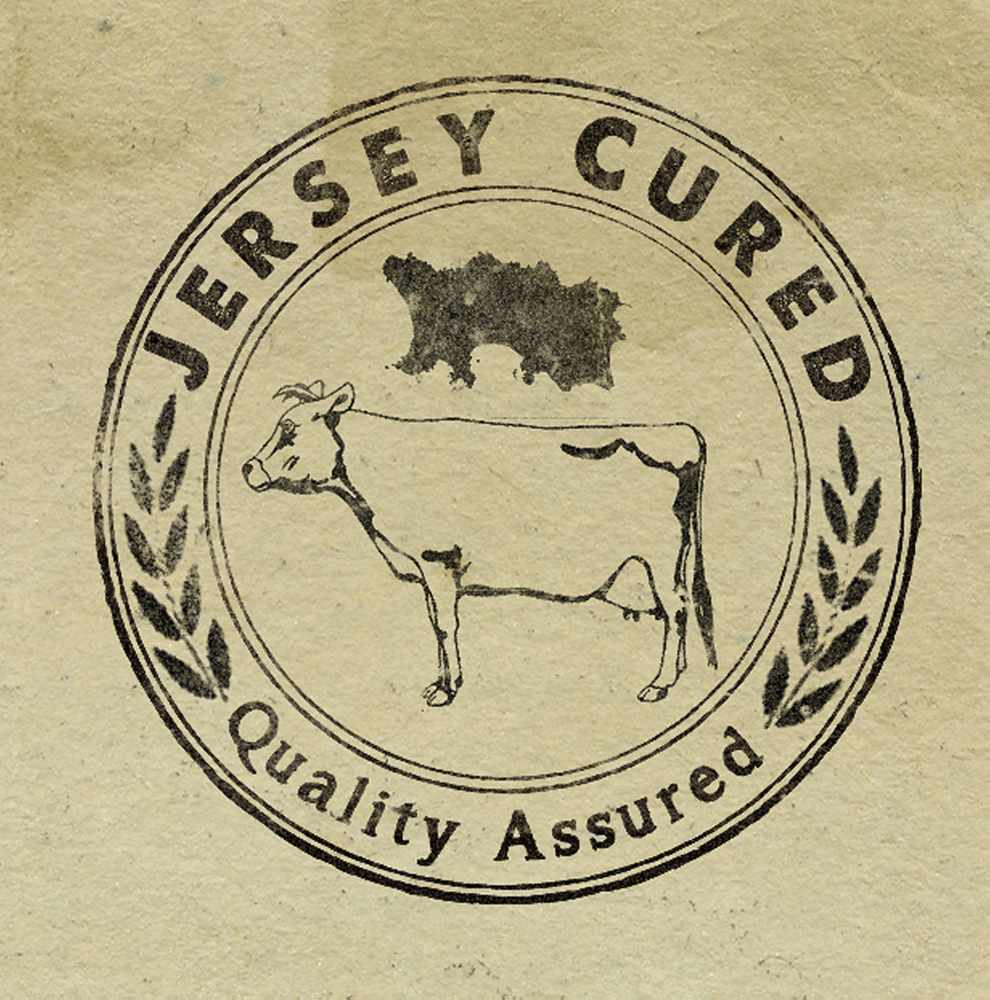
‘The Jersey cow is such a well-respected, beautiful animal, and we get such good dairy products from it, and I wondered what happened to the meat, and what it would taste like if it was cured,’ she said.
‘I want to use the meat once the animals have expired their useful dairy capabilities.’
With the idea in place, she undertook months of research, not just with the cooking method, but also making sure that she complied with environmental health guidelines.
She looked into the Italian and Swiss ways of curing, the bresaola and the Bündnerfleisch, and after nearly a year of trying different methods of curing, she decided that the traditional techniques were the best.
‘I don’t like to give too much away, but it involves refrigeration, certain recipes of salts, herbs and spices, and hanging for a certain period of time.’
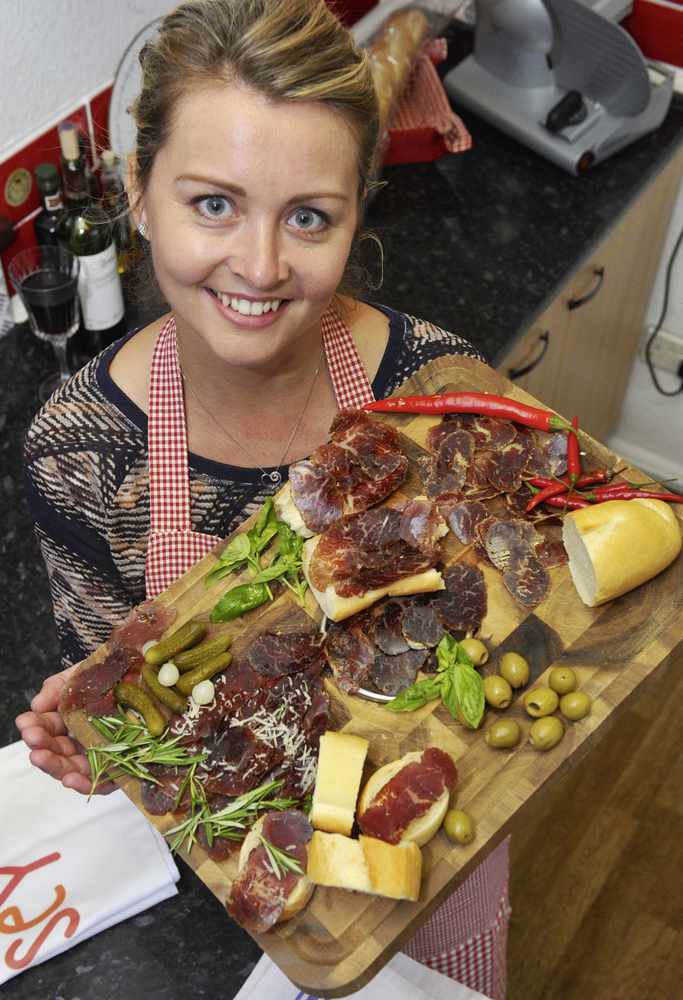
Having sourced her fresh meat direct from the butcher, she prepares the beef in her ‘spare’ kitchen at her home in St Clement, where the humidity and temperature are controlled.
‘It’s perfect, because we are by the coast and there’s no sun in the room but there is lots of fresh air, which is important for the meat,’ she said, adding that she has passed all the food hygiene tests so that batches of meat are of the same highstandard from butcher to the end product, which takes six to eight weeks.
‘I haven’t been in any rush,’ she said.
Work on her product has had to fit in a busy life as a working mum. Married to David, a stockbroker, Georgina works full-time in compliance, and has two daughters, Amelie (6) and Freya (2).
‘I wanted to make sure I did it the right way,’ she said.
‘With something as well respected as our Jersey cow, not just locally but globally, I need to make sure that I treat it with respect.’
Georgina is a member of Genuine Jersey, who she says have been very helpful.
‘Jersey Cured has a unique flavour.
‘I can eat it all the time.
Georgina will be curing to order as well as supplying local restaurants.
She has already created three types of cured Jersey beef: basil cured, rosemary cured and chilli cured.
She herself would serve her Jersey Cured beef on an antipasti platter in the continental way: some French bread and Jersey butter, a drizzle of olive oil and some shaved Parmesan.

She says she is lucky that her new venture can fit in around her job and her family, and adds that she is currently making schnapps with the apples and pears from her garden.
‘I am excited that I have done something I can be proud of, something I can put a passion into and call it my own,’ she said.
‘I used to sit in the kitchen when my mother was a chef and I watched her cook from a young age. I love cooking, I find it very relaxing.
‘And dad still gets involved with the slicing and the tasting.
‘He’s 76 now and I can see the pride in his face.
‘I love the fact that we can do this together.’
If you would like to order some Jersey Cured beef, email jerseycured@hotmail.com or phone 07797 789970

Fat has been making something of a comeback in recent years, and the latest advocates to sing its praises are sports scientist and marathon runner Professor Tim Noakes, nutritionist Sally Ann-Creed and chef and open-sea swimmer Jonno Proudfoot.
Their book, The Real Meal Revolution, has taken South Africa by storm and this summer landed on UK shores, promising to help people to lose weight without giving up all that juicy meat, butter and cream.
There is a catch, though – carbohydrates are strictly off the menu.
This low-carb, high-fat plan is similar to the Paleo diet, in that it advocates a return to eating what our hunter-gatherer ancestors ate 200,000 years ago, before we started cultivating grains.
It also draws heavily on the Banting diet devised by British undertaker William Banting, who gave up the carb-rich eating habits of the Victorians in the 1860s to cure himself of obesity.
Of course, no-carb, high-fat, high-protein diets have always attracted critics and fans alike. Prof Noakes, however, is convinced that this eating regime has benefited his own health.
‘We’ve been raised to believe that cholesterol, caused by eating too much fat, causes diseases, and that every disease in the book is linked to a high-fat diet.
‘It turns out that’s completely wrong,’ says Prof Noakes, who has Type 2 diabetes but, at 66, says he’s running like a 40-year-old.
‘What’s killing us is having elevated blood insulin concentrations all the time, and that is caused by high-carbohydrate diets.
‘It’s exacerbated in people like me, who have insulin resistance.
‘Insulin resistance is the most prevalent medical condition in the world – it dwarves everything else.’
To devise their recipes, Mr Proudfoot drew up three lists (green, orange and red) of foods people should eat in abundance, be wary of, and avoid altogether, with meat, cheese and leafy greens all on the green list; fruit, nuts and root veggies on the orange list; and all flour, grains, cake, rice, pasta, sugar, potatoes and even peas on the red list.
So popular has it been in South Africa that supermarkets have struggled to keep up with demand for Banting ingredients, including cauliflower, which forms the basis of several recipes, such as cauli-wraps, cauli-mash and cauli-rice.
Mr Proudfoot had the idea for a cookbook when he was training to swim from Mozambique to Madagascar and wanted to chart his diet.
He approached Prof Noakes and Ms Creed, and together the three have come up with a radical attack on carbohydrates.
As well as the obvious – ditching refined carbs like white bread and pasta – the trio take it a hefty step further, suggesting that wholegrains are cut, too.
Not that Prof Noakes is convinced they even really exist.
‘There’s no such thing as wholegrains, because you can’t digest them – that’s a marketing angle,’ he said.
‘Our health deteriorated the minute we started eating grains.
‘Our teeth went rotten, the bacteria in the mouth changed when we started eating carbs and then we lost height and we’ve only got back to the height we were 15,000 years ago in the last 20 or 30 years, which is quite astonishing.’
Instead of getting energy from carbs, The Real Meal Revolution aims to ‘retrain’ the body to run on fat, which keeps you fuller for longer, so lots of butter, coconut oil, full-fat cream and cheese go into the recipes.
Prof Noakes acknowledges it’s not a one-size-fits-all diet, but recommends that insulin-resistant people, with a family history of diabetes, should try it.
‘For most people, once you get over 40 and you’re a little overweight, you should be on this diet, because if you’re not, you’re in trouble.’
Here is a recipe from the book that you might like to try at home – although you should consult your GP before embarking on any extreme diet change, especially if you have a health condition.
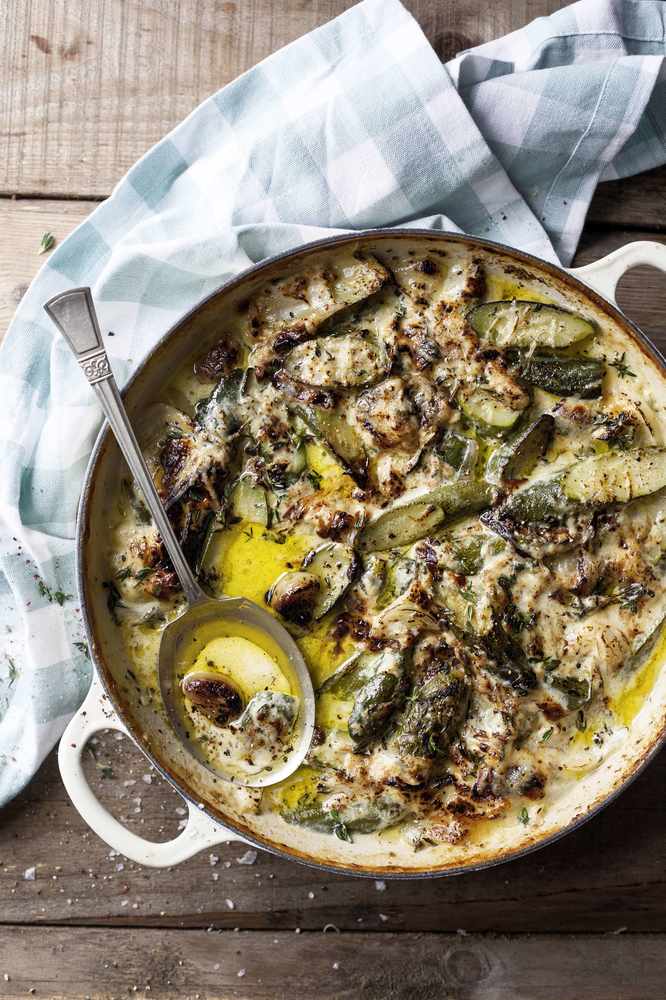
Ingredients – serves four
- 800g courgettes
- 1 onion, roughly sliced
- 1 handful thyme sprigs
- 1 whole head garlic, cloves peeled
- 100g butter, broken into pieces
- 250 ml double cream
- Salt and pepper
METHOD
1. Preheat oven to 200C (Gas 6).
2. Cut courgettes into large chunks. Lay onions, courgettes, thyme and garlic in an ovenproof lasagne dish (or casserole dish), mix well and press down.
3. Dot pieces of butter evenly over top of dish, then cover everything with double cream. Season with salt and pepper. Place the tray in oven, uncovered, and bake for 45 minutes.
4. If you want to thicken sauce in the bottom of tray, strain through a sieve and reduce it on the stove before pouring it back over.
Note: If you want some extra goodness, sprinkle a layer of grated cheese on top of the gratin before serving and pop it back under the grill for a cheesy crust.
The Real Meal Revolution: The Radical, Sustainable Approach To Healthy Eating by Professor Tim Noakes, Jonno Proudfoot and Sally Ann-Creed, is published by Robinson, priced £20.
By Caroline Moody

I DON’T know about you but when I think of going somewhere for Sunday lunch, it tends to be because it is for an older relative’s birthday and so it is a family outing in a pretty traditional (old-fashioned?) setting.
Perhaps the kind of place that still has prawn cocktail or fanned melon on the menu.
I am not sure why but I had not considered dining at the Radisson Blu Hotel for Sunday lunch before although, as with so many of our hotels, it is open to non-residents.
So, first things first.
First impressions were excellent thanks to easy parking in the ample car park, and a sunny autumnal day which allowed us to enjoy a pre-lunch drink on the terrace.
The Waterfront restaurant, which seats 140, has a bright and airy feel, with friendly, welcoming staff.
We sat at the window, the sun sparkling on the high tide in the marina, with a view across to Elizabeth Castle.
To start, I tried the chicken liver paté which was beautifully presented.
It was a pleasant surprise that the lettuce garnish had no dressing, quite a rare thing to find these days.
Sunday lunch is all about a roast, so while Mr M tucked into a wonderfully tender piece of lamb, I opted for the beef, which was delicious.
There were three small-ish slices, but they were tasty and had a good thickness.
For me, it was perfectly done.
With four roast potatoes and a huge Yorkshire pud, I was filling up quickly.
I noticed that it came with gravy on the plate.
Recently I was somewhere where the gravy was served on the side in its own jug, which I thought was a good idea, to allow people to help themselves to as much or as little as you liked.
By now I really didn’t have room for a big dessert.
There was no way I could have opted for the rich chocolate tart with Chantilly cream and orange compôte.
So I chose what I considered to be the smallest dish, a lemon posset.
I was so glad I did.
Served in a small round bowl, it was full of zesty punch.
It ticked all my boxes as far as dessert is concerned because it came with cream and a shortbread biscuit.
Mr M said the sticky toffee pudding was one of the best he has had the pleasure of tasting.
And he should know.
He has it everywhere he goes.
It didn’t hold back on the caramel sauce, which includes black butter, and there was ice cream too.
The Radisson is a great place to while away a few hours of relaxation.
As we left, the spacious lounge had come alive with some live background music, guests who were enjoying afternoon tea, and some who were just reading the Sunday papers over coffee.
I will definitely be thinking of taking the family there next time we want to meet for Sunday lunch.
ON THE PLATE
Caroline ate: Chicken liver pot, with toasted farmhouse bread and red onion jam; Traditional roast beef and Yorkshire pudding, oven-roasted potatoes, celeriac purée and tasty beef gravy; Lemon posset, topped with a winter berry compôte.
Mr M ate: Crispy fried smoked duck, peppered rocket, plum jam; Slow braised rump of lamb, cabbage mash, a light minted jus; Sticky toffee pudding, caramel and Jersey black butter sauce, vanilla ice cream.
THE OFFER: Two-for-one Sunday lunch. Applies to the three-course menu. Cost £32.50 (for two). Contact: 671100.
How they describe themselves? A chic venue with a cosmopolitan atmosphere.
The executive chef serves up a bold menu for food lovers, including local dishes and fresh and quirky daily specials.
